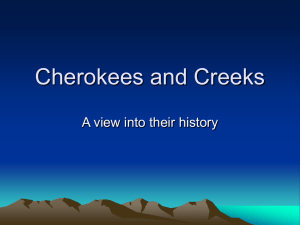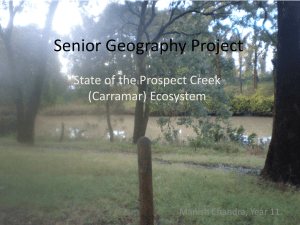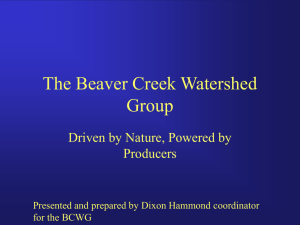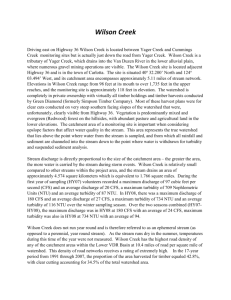Fine sediment sources in coastal watersheds with uplifted marine
advertisement
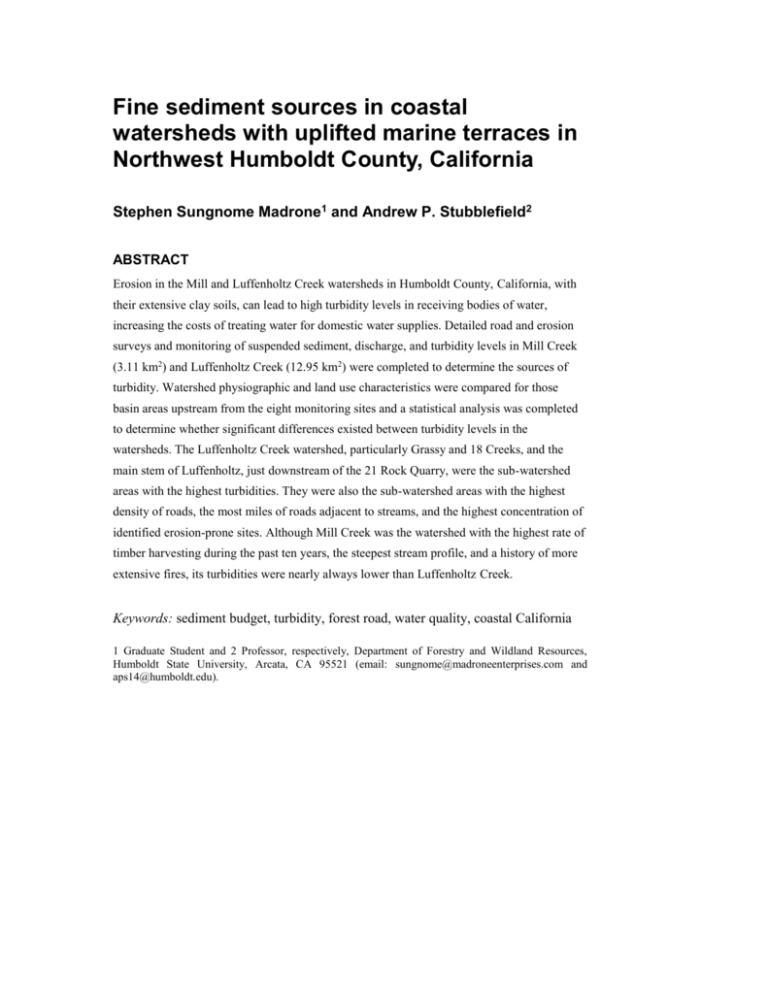
Fine sediment sources in coastal watersheds with uplifted marine terraces in Northwest Humboldt County, California Stephen Sungnome Madrone1 and Andrew P. Stubblefield2 ABSTRACT Erosion in the Mill and Luffenholtz Creek watersheds in Humboldt County, California, with their extensive clay soils, can lead to high turbidity levels in receiving bodies of water, increasing the costs of treating water for domestic water supplies. Detailed road and erosion surveys and monitoring of suspended sediment, discharge, and turbidity levels in Mill Creek (3.11 km2) and Luffenholtz Creek (12.95 km2) were completed to determine the sources of turbidity. Watershed physiographic and land use characteristics were compared for those basin areas upstream from the eight monitoring sites and a statistical analysis was completed to determine whether significant differences existed between turbidity levels in the watersheds. The Luffenholtz Creek watershed, particularly Grassy and 18 Creeks, and the main stem of Luffenholtz, just downstream of the 21 Rock Quarry, were the sub-watershed areas with the highest turbidities. They were also the sub-watershed areas with the highest density of roads, the most miles of roads adjacent to streams, and the highest concentration of identified erosion-prone sites. Although Mill Creek was the watershed with the highest rate of timber harvesting during the past ten years, the steepest stream profile, and a history of more extensive fires, its turbidities were nearly always lower than Luffenholtz Creek. Keywords: sediment budget, turbidity, forest road, water quality, coastal California 1 Graduate Student and 2 Professor, respectively, Department of Forestry and Wildland Resources, Humboldt State University, Arcata, CA 95521 (email: sungnome@madroneenterprises.com and aps14@humboldt.edu). GENERAL TECHNICAL REPORT PSW-GTR-19x Introduction Turbidity in Luffenholtz Creek, north coastal California, has increased treatment costs for the City of Trinidad. Excessive turbidity, especially the kind caused by erosion of colloidal clay, can be expensive and difficult to treat. Even with effective use of filters and chemical alars (which floc the clay particles together allowing filtration) there is still the potential for creation of a dangerous by-product, chloro-trihalomethanes that can remain in the treated water. This by-product is a known cancer-causing agent (Winzler and Kelly 2008). High turbidities can lead to water shortage emergencies and can create safety hazards for the community; storage shortages can occur from brief firefighting efforts or broken pipes during a freeze. Storage tank recharge can be difficult during periods of high turbidity. Creeks draining the Trinidad Area terraces were considered by Boyd (1978) to be possible sources of water quality degradation in the Area of Special Biological Significance (ASBS). This ASBS is a specifically designated sensitive coastal area in and around Trinidad Bay in the area near where Mill and Luffenholtz Creeks drain into the ocean (fig 1). The objective of this study is to locate and prioritize for treatment the sources of fine sediment in these coastal watersheds dominated by uplifted marine terraces. This study will help inform the efforts to improve water quality in these streams for humans and aquatic species. For this investigation we formed two hypotheses. The first is that road density and adjacency have a greater effect on turbidity than other physiographic and land use characteristics on these uplifted marine terraces, and that because of this Luffenholtz Creek will have higher turbidities than Mill Creek. The second hypothesis is that the 0.8 kilometer section of the CR 1000 Road immediately below the 21 Rock Quarry is a significant contributor of turbidity to Luffenholtz Creek due to its immediate proximity to the stream. Study Site Luffenholtz and Mill Creeks were chosen for study because they represent unique, and not well studied, topography for this region. They provide habitat for endangered species and water supplies for domestic use. Study sites are shown in Figure 1. Both creeks support populations of anadromous steelhead trout (Oncorhynchus mykiss), an Endangered Species Act Listed species, and cutthroat trout (Oncorhynchus clarki). The Mill Creek watershed is 404 ha in size, and lies on the north side of the City. It was the original water supply and is now the back up or alternative water supply. The Luffenholtz Creek watershed is 1527 ha in size and is the primary source of water for the citizens of the City of Trinidad, population 311, and other watershed residents. As the Mill and Luffenholtz Creek watersheds are adjacent and have similar soils, rainfall, and geological formations, they were expected to have similar particle characteristics and turbidity levels. Comprehensive sediment source assessments have been completed recently for most of the watersheds that drain the Trinidad Terraces area, including Mill and Luffenholtz Creeks (Allan and Ledwith 2008). Water quality sampling on the two creeks was done in spring of 2007 by Cinowalt and Van Matre (unpublished). Sampling at the mouths of all the main local creeks, draining this uplifted terrace Fine sediment sources in coastal watersheds with uplifted marine terraces in Northwest Humboldt County, California Figure 1—Study Watersheds area, was carried out in 2006 through 2009, by Madrone and Allan (unpublished). My project builds on these recent studies. The grab samples taken over a four-year period increased from one per year in 2006 to 42 samples in Water Year 2009. This increased sampling was also focused completely on Mill and Luffenholtz Creeks for WY 2009. The results of this sampling were used to compare with watershed characteristics and land use variables. These variables included the results from detailed on-the ground roads and creek surveys in order to determine what and how big the sources of sediment were, whether there was delivery potential, and how they affected turbidity. Table 1 provides the detailed watershed characteristics and land use variables that make up the different sub-basins of the Luffenholtz and Mill Creek watersheds. These details include geology, fire history, drainage area and basin relief, road surfacing, densities and lengths, timber harvest history, harvesting types and techniques, past and potential soil loss. The following discussion highlights the table information. GENERAL TECHNICAL REPORT PSW-GTR-19x The geologic map for the Trinidad area shows that Mill Creek drains predominantly Franciscan rocks. Luffenholtz also has significant areas of Franciscan geology, mostly in the inner canyon and on slopes between terraces. The remainder of both watersheds is underlain by uplifted marine terrace soils. The Franciscan soil types have higher clay content (23-40%) in the A and B horizons than the Marine Terrace soil types (13-30%). Both soil types have high clay contents (fig 2). Methods We used the methods listed below to evaluate sediment sources for two small coastal watersheds in Northwest California, USA. Seven sources of data are utilized in this analysis including road erosion and sedimentation assessments completed in 2007, by Madrone, D. Allan, and T. Ledwith of the Redwood Community Action Agency for all of Mill and Luffenholtz Creeks. This included an aerial photo analysis as well as a 100% survey of all roads and stream crossing sites. Grab samples for turbidity were collected near the mouths of Mill and Luffenholtz Creeks, as well as other local creeks that drain into the ASBS area or the bay, in 2006-2009 by Allan and Madrone. Grab samples for turbidity and SSC were collected in spring 2007 by Cinnowalt and Van Matre at Site 1 on Luffenholtz Creek and downstream 0.5 kilometers from Site 2 on Mill Creek. Stream bank and landslide erosion inventories and assessments were completed in spring 2008 by Allan and Madrone, for the inner canyon areas on Mill and Luffenholtz Creeks. GIS mapping was completed by M. Lawler and included 2009 data collected by the author on timber harvest history of silvicultural and yarding methods, and rate of harvest, parcel boundaries, soils, geology, fire history, and locations of roads and streams. Grab samples for turbidity and flow measurements were collected in WY 2009 by Madrone at Site 1 on Luffenholtz Creek, at Site 2 on Mill Creek, and at 6 tributary sites upstream in Mill and Luffenholtz Creeks. Continuous probe sensors for turbidity and stage were maintained at Site 1 on Luffenholtz Creek and at Site 2 on Mill Creek in the spring of 2009. The relationship between turbidity and SSC in these 2007 samples was used to generate SSC for the 42 turbidity grab samples taken at Sites 1 and 2 in water year (WY) 2009. Suspended sediment loads were computed for three late season storms in WY2009 using automated turbidity data as a surrogate for suspended sediment concentration (SSC, mg/l) (Lewis and Eads, 2001). The storm dates (5/1 to 5/4/09, 5/4 to 5/9/09, and 5/13 to 5/17/09) were chosen because these were the only storms for which both sites had reliable continuous turbidity data. Results As compared to Luffenholtz Creek, Mill Creek is smaller, steeper, has more unstable ground and has burned more completely and more often in the past 100 years. Mill Creek has had a higher rate of timber harvest in the past ten years than Luffenholtz Creek, but in the harvested areas buffers were left along the creeks and the logging was completed on less erodible ground. Mill Creek was also harvested with less disturbing shovel-logging excavators with a loader head. Notably, Mill Creek does have a lower road density and less road adjacency to streams and therefore less delivery potential. Swift (1988) also found that roads and skid trails were a major source of sediment from forestry-related activities. Fine sediment sources in coastal watersheds with uplifted marine terraces in Northwest Humboldt County, California Luffenholtz Creek has a legacy of riparian roads with close proximity and thereby delivery, as well as a high road density, due in part to the dendritic nature of the channel network. It has also had a high rate of annual timber harvesting over the past 40 years, including along its streams and in the inner canyon. Harvest rates in the 1980s and 90s averaged 4% per year including clear cutting with tractor logging. The watershed with the highest rate of harvest on steep ground and the highest density of roads also has the higher turbidities. Mill Creek is nearly always less turbid than main stem Luffenholtz Creek (fig 5). Suspended sediment load calculations for three storms (5/1 to 5/4, 5/4 to 5/9, and 5/13 to 5/17) in early May 2009 were 0.02 metric tons (6 x 10-5 t per ha) for Mill Creek and 21.29 metric tons (0.16 t per ha) for Luffenholtz Creek (fig 3 and 4). A plot of normalized flows for the two main stems based on the 42 grab samples in WY 2009 showed that flows are similar (cms per km2) for Luffenholtz and Mill creeks when normalized, but the North Fork is not similar (fig 5). Starting with the late December 2008 storms, the North Fork normalized discharge regularly exceeded that of Luffenholtz and Mill Creeks. The rainy season for WY 2009 can be characterized as being 75% of normal (112.7 centimeters compared to the 17 year average of 150.9 centimeters per year at Allan’s gage). Rainfall was about 21% higher in WY 2009 at the Luffenholtz Gage for a total of 143.4 centimeters. There were numerous dry periods between storms, with the only significant rainfall events (greater than 5 cm in 24 hours) happening on 12/28/08, 3/16/09, and 5/4/09. These events match up with the highest turbidities and stages recorded. Turbidities at Site 5 upstream of the 21 Rock Quarry were substantially lower during the first part of the season (from October 2008 through mid December 2008) than at the downstream Site 6 on Luffenholtz Creek. As the season progressed and after a large rainfall event (140 mm in 5 days) peaking on 12/28/08 the difference in turbidities between Site 5 and 6 was decreased. The rainfall events of 3/16 and 5/4 did not raise turbidities at Site 6 over Site 5. During the rainfall event of 54 mm in 6 hours on May 4th, while lower Luffenholtz, the North Fork, and Mill Creeks had a jump in turbidities, upper watershed Sites 4 through 8 showed little increase in turbidity. This suggests that the upper tributary retention basins had begun functioning again after a dry period in April. Statistical analysis of turbidities from WY 2009 grab samples was completed for several of the sites using non-parametric tests because the turbidity data did not pass normality. The P-values for all sites were less than 0.05 and because the data did not pass normality the median value is the parameter for all tests. The analysis is nonparametric in that actual values were not used, just their relative rank, or position toward one another. Luffenholtz Creek (Site 1) was found to have significantly higher turbidity than Mill Creek (Site 2) and Site 5 upstream of the 21 Quarry had significantly higher turbidity than the downstream Site 6. Discussion Joland Creek (South Fork Luffenholtz Creek) had the highest turbidities of all of the Luffenholtz Creek tributaries monitored under this study. The North Fork of Parker Creek and both forks of Two Creeks also had very high turbidities. These high turbidities may be associated with the high road densities of dirt and gravel roads coupled with year-round land and home site clearing activities. The results are from GENERAL TECHNICAL REPORT PSW-GTR-19x grab samples taken between 2006 and 2009. None of these tributaries flow into Luffenholtz Creek or Mill Creek above the City’s water intakes. Mill Creek has steeper average slopes and greater basin relief than Luffenholz Creek watershed and it has a greater percentage of its watershed in unstable geology. It has a higher rate of harvest during the past 10 years (44% for Mill vs. 20% for Luffenholtz), and has been burned more severely and more often, and yet it has lower turbidities than Luffenholtz Creek. This may be because it has a slightly lower density of roads per square kilometer (2.9 km per km2 for Mill to 3.1 km km2 for Luffenholtz), has fewer total kilometers of roads (9 for Mill and 40.2 for Luffenholtz), has fewer kilometers of native surface roads (5.8 to 25.7), and far fewer erosion sites (23 to 131) and less actual past soil loss (450 m3 for Mill Creek and 3680 m3 for Luffenholtz Creek) (table 1). Recent timber yarding in Mill Creek was done with shovels (excavators), cable, and helicopters. These operations left substantial wildlife, vegetative, and canopy buffers along all perennial streams and have stayed off of the steep less stable ground. Riparian buffer strips provide an efficient and widely accepted way to help protect aquatic ecosystems and downstream values from the effects of upslope landuse activities (Reid and Hilton 1998). Luffenholtz Creek watershed on the other hand is 4 times the size of Mill Creek and 10 times the size of the North Fork of Luffenholtz Creek (fig 1). It had a higher rate of harvest than Mill Creek in the 1980s and 1990s, some of which was clear-cutting on steep slopes in the inner canyon and the headwaters areas, and was done with crawler tractors. This has left a legacy of stored sediments along floodplain areas in the inner canyon. These stored sediments are mobilized at bankfull events, which is when elevated turbidities occur. Luffenholtz Creek has several roads immediately adjacent to the streams. It also has more overall kilometers of roads, more native roads, and more kilometers of high-use rocked roads. Therefore, Luffenholtz Creek has much more past erosion (3680 m3 for Luffenholtz Creek and 450 m3 for Mill Creek) and potential erosion sites and potential erosion (131 sites for Luffenholz Creek and 23 at Mill Creek’s, and 5270 m3 for Luffenholz Creek compared to 1040 m3 at Mill Creek) (tab 1). Rice and Sherbin (1977) noted that when considering erosion hazard in Northwest California the most important considerations probably are the yarding method used, the amount of roads, and the magnitude of storms actually experienced following the harvest. In conclusion, the data collected and analyzed for this study suggest that higher turbidities in Luffenholtz Creek, as compared to Mill Creek, are related to differences in timber harvest practices, higher road densities, more erosion-prone sites, and greater delivery potential. Data collected showing higher turbidities in the fall at Site 6 as compared to Site 5 suggest that this is due to the close proximity of the road to the creek and that a decrease in the turbidity difference later in winter and spring was due to exhaustion of fines from the road. Data collected suggest that the lower turbidities in Mill Creek are due to lower road densities, low delivery potential for sediment, and improved timber harvesting techniques that keep heavy equipment out of riparian areas and retain substantial forested buffers for sediment filtering. Fine sediment sources in coastal watersheds with uplifted marine terraces in Northwest Humboldt County, California References Allan, D. and T. Ledw ith. 2008. Watershed Assessment Action Plan for the Trinidad Terraces. Redwood Community Action Agency. Eureka, CA. Available from the City of Trinidad and the State Water Resources Control Board. 53 p. plus maps. Boyd, M. 1978. California marine waters areas of special biological significance reconnaissance survey report: kelp beds at Trinidad Head. Water Quality Monitoring Report no.79-19 Available from the State Water Resources Control Board. 35 p. Lewis, J., and Eads, R. 2001. Turbidity threshold sampling for suspended sediment load estimation. In: Proceedings of the 7th Federal Interagency Sedimentation Conference, 25-29 Mar 2001, Reno, Nevada. Pp. III-110 to III- 117. Madrone, Stephen. 2011. Fine sediment sources of coastal watershed with uplifted marine terraces in Northwest Humboldt County, California. Arcata, CA: Humboldt State University; 90. Master of Science. thesis. Reid, L.M.; Hilton, S. 1998. Buffering the buffer. In: Ziemer, R.R., tech. coord. In: Proceedings of the Conference on Coastal Watersheds: The Caspar Creek Story. General Technical Report PSW-GTR-168. Albany, CA: U.S. Department of Agriculture, Forest Service, Pacific Southwest Research Station: 71-80 p. Rice, R. M., and Sherbin, S. A. 1977. Estimating sedimentation from an erosion-hazard rating. USDA Forest Service Research Note PSW-323. 4 pp. Winzler and Kelly, 2008. Water System Options for improvements, to the City of Trinidad, Trinidad, California. Preliminary Engineering Report, June, 2008. Figure 2—Road assessment sites, geology, timber harvesting (20002010) Table 1—Site/sub-basin characteristics Item GPS Locations Site 2 Site 4 Site 1 Site 3 Site 5 Site 6 Site 7 Site 8 Main Stem North Fork Luffenholtz Luffenholtz Main Stem Mill Upper Mill Luffenholtz Luffenholtz Creek Above 21 Creek Below 21 Eighteen Creek Creek Creek Creek Quarry Quarry Grassy Creek Creek N41°03'56" N41°04'59" N41°02'50.5" N41°03'49.7" N41°03'54.5" N41°03'39.9" N41°03'12.2" N41°02'55.2" W124°08'24.7" W124°07'1.2" W124°06'47.5" W124°06'10.2" W124°05'33.1" W124°05'31.9" W124°05'6.4" W124°05'2.7" Watershed Characteristics Drainage Area (Hectares) 311 127 1295 129 153 171 231 153 Hydrologic Network Linear Dendritic Dendritic Linear Dendritic Dendritic Dendritic Dendritic Basin Relief (ft) 1164 608 1039 606 561 601 580 713 Basin Relief (m) 355 185 317 185 171 183 177 217 Relief Ratio 17 30 15 16 21 18 21 23 Geology % Franciscan 70 60 62 66 67 67 80 60 Geology % Marine Seds. 30 40 38 34 33 33 20 40 Kilometers road per Kilometer 2 3 2 3 5 4 4 5 7 Kilometer road 9 3 40 6 6 7 11 11 Kilometers road on native surface 6 1 26 4 4 4 8 5 Kilometers road on rocked surface 3 1 15 2 2 2 3 6 Past soil loss (20 years) (m 3 ) 450 390 3680 220 230 1530 180 1520 # potential erosion sites 23 15 131 22 18 24 23 20 # sites per square kilometer 7 12 10 17 12 14 10 13 Potential soil loss (m3) 1040 10 5270 960 270 650 970 1040 Potential soil loss (m3/kilometer 2) 330 10 410 740 180 380 420 580 % harvested 2000-2010 44 25 20 50 30 40 20 50 % harvested 1990-1999 7 0 40 10 30 30 60 10 % harvested 1979-1989 <5 0 40 30 20 10 10 30 % area burned 1906 fires 0 0 0 0 0 0 0 0 % area burned 1936 fires 50 100 30 67 100 100 30 0 % area burned 1945 fires 60 100 30 75 80 76 40 0 Land Use Variables Luffenholtz Creek Water Year 2009 Mill Creek Water Year 2009 700 7.0 Corrected Turbidity Corrected Turbidity 300 300 250 200 ` 20 15 Discharge (cms) 350 Storm 2: May 4-9, 2009 Storm 1: May 1-4, 2009 400 Storm 3: May 13-17, 2009 450 6.0 Discharge 250 200 150 10 100 5 50 5.0 ` 4.0 3.0 2.0 150 100 1.0 50 0 5/1/09 5/3/09 5/5/09 5/7/09 5/9/09 5/11/09 5/13/09 5/15/09 5/17/09 0 5/1/09 0 5/19/09 5/3/09 5/5/09 5/7/09 5/9/09 5/11/09 5/13/09 5/15/09 5/17/09 0.0 5/19/09 Date Date Figure 3—Hydrograph and Turbidigraph for three storm period, Luffenholtz Creek, Humboldt County, CA Figure 4—Hydrograph and Turbidigraph for three storm period, Mill Creek, Humboldt County, CA Turbidity (NTRU's) 200 180 Site 1 - Main Stem Luffenholtz Creek 160 Site 2 - Main Stem Mill Creek 140 Site 3 - North Fork Luffenholtz Creek 120 100 80 60 40 0 10/2/08 10/3/08 10/3/08 10/4/08 11/1/08 11/2/08 11/3/08 11/8/08 11/11/08 11/12/08 11/20/08 12/12/08 12/13/08 12/14/08 12/16/08 12/21/08 12/22/08 12/25/08 12/28/08 1/2/09 1/25/09 2/6/09 2/9/09 2/13/09 2/14/09 2/15/09 2/22/09 2/23/09 2/23/09 2/28/09 3/2/09 3/4/09 3/14/09 3/15/09 3/15/09 3/16/09 3/21/09 4/2/09 4/9/09 4/10/09 5/2/09 5/4/09 5/7/09 5/13/09 20 Date 1.20 Discharge (cms/km2) 1.00 Site 1 - Main Stem Luffenholtz Creek Site 2 - Main Stem Mill Creek 0.80 Site 3 - North Fork Luffenholtz Creek 0.60 0.40 0.00 10/2/08 10/3/08 10/3/08 10/4/08 11/1/08 11/2/08 11/3/08 11/8/08 11/11/08 11/12/08 11/20/08 12/12/08 12/13/08 12/14/08 12/16/08 12/21/08 12/22/08 12/25/08 12/28/08 1/2/09 1/25/09 2/6/09 2/9/09 2/13/09 2/14/09 2/15/09 2/22/09 2/23/09 2/23/09 2/28/09 3/2/09 3/4/09 3/14/09 3/15/09 3/15/09 3/16/09 3/21/09 4/2/09 4/9/09 4/10/09 5/2/09 5/4/09 5/7/09 5/13/09 0.20 Date Figure 5—WY 2009 Grab sample Turbidity and Discharge data for Main Stem Luffenholtz Creek vs. Main Stem Mill Creek vs. North Fork Luffenholtz Crek, Humboldt County, CA Table 2—Watershed Road Densities Creek Site # Kilometer road Drainage area (km 2 ) Road density (km/km2 ) Luffenholtz South Fork North Fork South Fork Creek at Joland Creek Mill Creek at Parker Creek Parker Creek McConnahas Dead Man's North Fork Two Creeks Two Creeks Two Creeks Westhaven at Westhaven Stagecoach at Scenic at Scenic Mill Creek at Gulch at at Westhaven at Scenic Drive Drive Road Drive Drive Scenic Drive Scenic Drive at 2 nd Avenue Drive Drive Site 1 Site A Site B Site C Site D Site E Site F Site G Site H Site I 40.0 3.4 9.0 N/A 2.3 4.1 0.6 N/A N/A 4.3 13.0 0.5 3.1 N/A 0.3 2.7 0.3 N/A N/A 0.9 3.0 6.8 3.0 N/A 6.8 1.5 2.0 N/A N/A 5.0 Discharge (cms) 25 Storm 3: May 13-17, 2009 500 Storm 2: May 4-9, 2009 550 Storm 1: May 1-4, 2009 30 Discharge Corrected Turbidity (Hach Equivalent NTRU) 600 Corrected Turbidity (Hach Equivalent NTRU) 350 35 650



